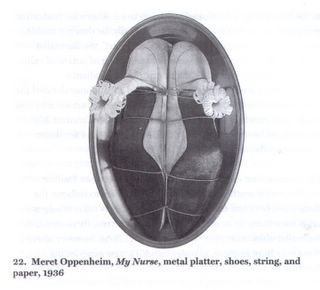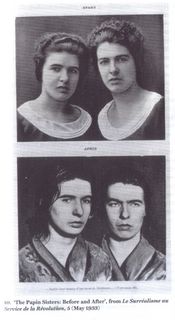Wednesday, February 16, 2005
Regular consumption of surrealism makes for a critical mind of anti-rust kind.
From David hopkins' "Dada and surrealism: A very short introduction":

Oppenheim once observed that the shoes evoked for her the idea of 'thighs squeezed together in pleasure', in belated recognition of the 'sensual atmosphere' which her childhood nurse had exuded. Possibly she is ironizing the whole issue of female fetishism here. Female fetishism, if it exists, would be predicated on the psychological function of fetishism for men, which is normally assumed to be heterosexual in basis. Dali's object certainly upholds this. Surely there is more than a hint of a lesbian fantasy in Oppenheim's comment. One can easily see the trussed-up shoes, which double as a turkey on a platter, as constituting some form of bondage fantasy on the part of the artist.

The Papin sisters had committed one of the grisliest and most sensational crimes to hit early 1930s France. A text in the same Surrealist journal, in a section dedicated to 'fait divers' or bizarre new items, told how these impeccably bourgeois young ladies, having been placed in service by their mother in a respectable Le Mans household, had developed a loathing for their employers and had ended up murdering them with ritualistic precision, tearing out their eyes and smashing their heads.
On one level the dual photograph of the sisters, which registered an extraordinary change in their physiognomies, corresponded to the Surrealist's fascination with 'convulsive beauty'; a kind of physical jolt in relation to extraordinary visual phenomena which will be discussed later. However, the Surrealists also sympathized with the violent response to servitude represented by the sisters' act. Believing that accepted morality often served to cover up ethical cowardice, the Surrealists had venerated criminals on other occasions.
From David hopkins' "Dada and surrealism: A very short introduction":

Oppenheim once observed that the shoes evoked for her the idea of 'thighs squeezed together in pleasure', in belated recognition of the 'sensual atmosphere' which her childhood nurse had exuded. Possibly she is ironizing the whole issue of female fetishism here. Female fetishism, if it exists, would be predicated on the psychological function of fetishism for men, which is normally assumed to be heterosexual in basis. Dali's object certainly upholds this. Surely there is more than a hint of a lesbian fantasy in Oppenheim's comment. One can easily see the trussed-up shoes, which double as a turkey on a platter, as constituting some form of bondage fantasy on the part of the artist.


The Papin sisters had committed one of the grisliest and most sensational crimes to hit early 1930s France. A text in the same Surrealist journal, in a section dedicated to 'fait divers' or bizarre new items, told how these impeccably bourgeois young ladies, having been placed in service by their mother in a respectable Le Mans household, had developed a loathing for their employers and had ended up murdering them with ritualistic precision, tearing out their eyes and smashing their heads.
On one level the dual photograph of the sisters, which registered an extraordinary change in their physiognomies, corresponded to the Surrealist's fascination with 'convulsive beauty'; a kind of physical jolt in relation to extraordinary visual phenomena which will be discussed later. However, the Surrealists also sympathized with the violent response to servitude represented by the sisters' act. Believing that accepted morality often served to cover up ethical cowardice, the Surrealists had venerated criminals on other occasions.


